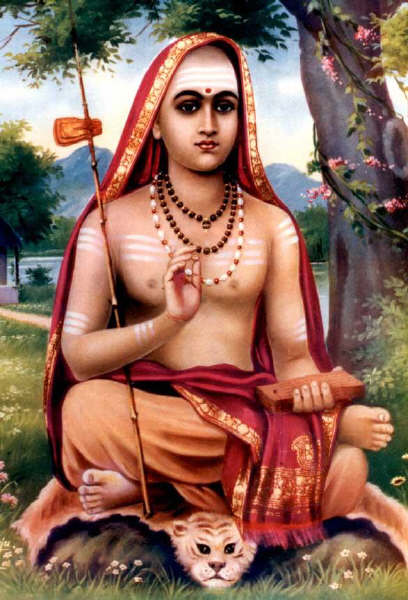 Adi Shankaracharya
Adi ShankaracharyaAdi Shankara (IAST: Ādi Śaṅkara pronounced [aːd̪i ɕaŋkərə], (Sanskrit: आदि शङ्करः, Adi Sankarar Malayalam: ആദി ശങ്കരന് Ādi Śaṅkaran, Tamil: ஆதிசங்கரர்), also known as Śaṅkara Bhagavatpādācārya and Ādi Śaṅkarācārya was an Indian guru from Kalady of present day Kerala who consolidated the doctrine of advaita vedānta. His teachings are based on the unity of the ātman and brahman— non-dual brahman, in which brahman is viewed as nirguna brahman, brahman without attributes.
Shankara travelled across India and other parts of South Asia to propagate his philosophy through discourses and debates with other thinkers. He is reputed to have founded four mathas (“monasteries”), which helped in the historical development, revival and spread of Advaita Vedanta. Adi Shankara is believed to be the organizer of the Dashanami monastic order and the founder of the Shanmata tradition of worship.
His works in Sanskrit concern themselves with establishing the doctrine of advaita (nondualism). He also established the importance of monastic life as sanctioned in the Upanishads and Brahma Sutra, in a time when the Mimamsa school established strict ritualism and ridiculed monasticism. Shankara represented his works as elaborating on ideas found in the Upanishads, and he wrote copious commentaries on the Vedic canon (Brahma Sutra, principal upanishads and Bhagavad Gita) in support of his thesis. The main opponent in his work is the Mimamsa school of thought, though he also offers arguments against the views of some other schools like Samkhya and certain schools of Buddhism.
Life
Traditional accounts of Adi Shankara’s life can be found in the Shankara Vijayams, which are poetic works that contain a mix of biographical and legendary material, written in the epic style. The most important among these biographies are the Mādhavīya Śaṅkara Vijayaṃ (of Mādhava, c. 14th century), the Cidvilāsīya Śaṅkara Vijayaṃ (of Cidvilāsa, c. between 15th century and 17th century), and the Keraļīya Śaṅkara Vijayaṃ (of the Kerala region, extant from c. 17th century).
Shankara was born in the achariar community to Sivaguru and Aryamba in Kaladi (olden Tamizhakam ) in central present day Kerala,4 km from Nedumbassery airport, Kochi. According to lore, it was after his parents, who had been childless for many years, prayed at the Vadakkunnathan temple, Thrissur that Sankara was born under the star Thiruvathira.
His father died while Shankara was very young. Shankara’s upanayanaṃ, the initiation into student-life, had to be delayed due to the death of his father, and was then performed by his mother. As a child, Shankara showed remarkable scholarship, mastering the four Vedas by the age of eight.
Sannyasa
At the tender age of 7, Shankara was inclined towards sannyasa, but it was only after much persuasion that his mother finally gave her consent. He only received her consent in a very interesting manner. While bathing in the river Poorna one day, a crocodile caught hold of his leg. Shankara appealed to his mother, who had arrived at Poorna, asking for permission to become a sanyasi. His mother finally gave consent, only to have the crocodile let go of young Shankara. A crocodile had never been found in Poorna ever or since[8] Shankara then left Kerala and travelled towards North India in search of a guru. On the banks of the Narmada River, he met Govinda Bhagavatpada the disciple of Gaudapada at Omkareshwar. When Govinda Bhagavatpada asked Shankara’s identity, he replied with an extempore verse that brought out the Advaita Vedanta philosophy. Govinda Bhagavatapada was impressed and took Shankara as his disciple.
The guru instructed Shankara to write a commentary on the Brahma Sutras and propagate the Advaita philosophy. Shankara travelled to Kashi, where a young man named Sanandana, hailing from Chola territory in South India, became his first disciple. According to legend, while on his way to the Vishwanath Temple, Sankara came upon an untouchable accompanied by four dogs. When asked to move aside by Shankara’s disciples, the untouchable replied: “Do you wish that I move my ever lasting Ātman (“the Self”), or this body made of flesh?” Realizing that the untouchable was none other than god Shiva himself, and his dogs the four Vedas, Shankara prostrated himself before him, composing five shlokas known as Manisha Panchakam.
At Badari he wrote his famous Bhashyas (“commentaries”) and Prakarana granthas (“philosophical treatises”).

No comments yet.